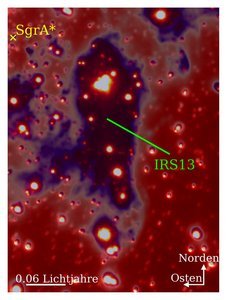German astrophysicist discovers a turbulent fountain of youth in the center of our galaxy with a remarkable formation history

A team of researchers led by Dr Florian Peißker at the University of Cologne’s Institute of Astrophysics has discovered an unexpectedly large number of young stars in the vicinity of a supermassive black hole. The study, titled ‘The Evaporating Massive Embedded Stellar Cluster IRS 13 Close to Sgr A*. Detection of a Rich Population of Dusty Objects in the IRS13 Cluster’ and published in The Astrophysical Journal, suggests that the star cluster IRS13, discovered over twenty years ago, migrated towards the supermassive black hole through a variety of processes, with its formation history being turbulent.
The researchers used a wide variety of data gathered over several decades from various telescopes to determine the cluster members in detail. The stars are a few hundred thousand years old, which is considered young for such conditions. Given the high-energy radiation and tidal forces of the galaxy, it is unexpected to have such a large number of young stars in the direct vicinity of the supermassive black hole.
In addition to the discovery of young stars, the researchers found water ice at the center of our galaxy for the first time. The James Webb Space Telescope (JWST) was used for the study, and the prism on board the telescope used to record a spectrum free of atmospheric interference from the Galactic Center was developed at the Institute of Astrophysics in the working group led by Professor Dr. Andreas Eckart, a co-author of the publication. The presence of water ice around very young stellar objects is another independent indicator of the young age of some stars near the black hole.
The researchers also found that IRS13 has a turbulent history of formation behind it and that it migrated towards the supermassive black hole through friction with the interstellar medium, collisions with other star clusters, or internal processes. From a certain distance, the cluster was then captured by the gravitation of the black hole. In this process, a bow shock may have formed at the top of the cluster from the dust surrounding the cluster, similar to the tip of a ship in the water. The increase in dust density stimulated further star formation, which explains why these young stars are mostly at the top or front of the cluster.
According to Dr Peißker, the analysis of IRS13 and the accompanying interpretation of the cluster is the first attempt to unravel a decade-old mystery about the unexpectedly young stars in the Galactic Center. Dr. Michal Zajaček, the second author of the study and scientist at Masaryk University in Brno (Czech Republic), added that the star cluster IRS13 may be the key to unraveling the origin of the dense star population at the center of our galaxy. The researchers have gathered extensive evidence that very young stars within the range of the supermassive black hole may have formed in star clusters such as IRS13, and have identified star populations of different ages in the cluster so close to the center of the Milky Way.
Further Information:
https://iopscience.iop.org/article/10.3847/1538-4357/acf6b5

 How to resolve AdBlock issue?
How to resolve AdBlock issue?